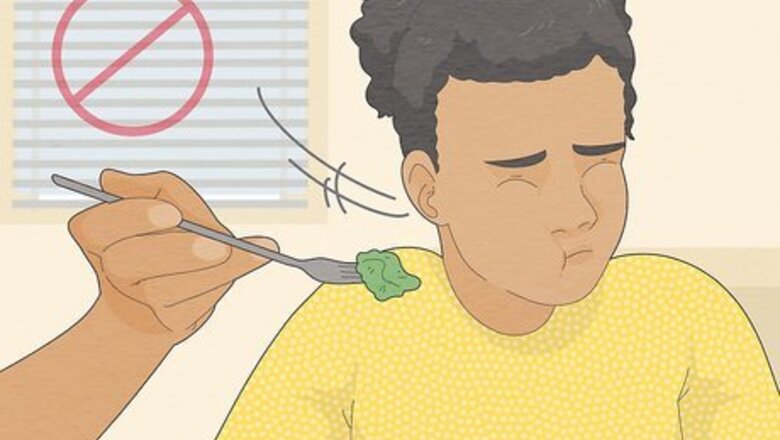
views
Helping Children Learn to Like Healthy Foods

Don't force children to eat when they're full. While getting kids to join the “clean plate club” might seem like a good idea, it can actually cause them to develop picky eating habits. Since being overfull can cause stomach pain or other gastrointestinal problems, children who've been encouraged to eat more than they need may slowly begin to dislike eating due to the negative experience.

Introduce new foods gradually. New tastes, textures, and smells can be a little scary for children, but a lack of skills or opportunities to develop eating skills needed to eat a variety of foods can help a child become too picky. Put very small portions of unfamiliar items on their plates, and don't make a big deal about the new arrival. You can also incorporate new foods into dishes that include items you know your kids like. For example, maybe your child has never had spinach. If you know they love creamy foods, try starting off with creamed spinach rather than a spinach salad. You can also try broccoli and cheese if they like cheesy flavors. A lack of variety in foods being offered limits exposure and experiences to familiar foods only and helps children become picky eaters.

Fill children's plates with colors and fun shapes. Make your meals into a game! Rather than encouraging children to eat their carrots, tell them they need to eat “the orange food” to complete the rainbow. You can also use cookie cutters to transform unappealing items into circles, stars, or squares. Tell your child they need to “collect” each shape.

Avoid making elaborate separate meals for different kids. You don't have to be everyone's personal chef. This can lead to a lot of extra work and frustration for you. Sometimes, the choice of "it's this or making yourself a PB&J" is enough to get a kid to agree to try something new. Let your kid make themselves food if they can't tolerate what you're serving. You can suggest healthy options like a sandwich or high-fiber cereal. Help them if they need it, but don't go to the extra work of cooking up something big. This helps them take personal responsibility without being punished.

Involve kids in shopping and meal prep. This will help children to feel invested in what they eat. Especially when you're in the produce or meat sections, ask them to pick out a few ingredients that they'd like to try. Then, get them to help you pick out a recipe and prepare the meal. Later, if they say don't like something, remind them that they chose it. This may be enough to get them to try a bite or two.

Let dessert be dessert, not a reward. Bribing your children to eat just 2 more bites of peas in return for a bowl of ice cream isn't a good idea. This can make them feel like sweets are the best foods, which they probably don't need more prompting to believe! It might also cause them to expect dessert after every meal. Instead, make 1 or 2 nights a week “dessert nights.”

Model good eating habits for your children if you can. Children learn by observation. If they see you eating a balanced mix of healthy foods, they'll be more likely to follow suit. However, watching you eating lots of soda, snack foods, and dessert will make them wonder why they can't do the same. If you're dealing with some bad dietary choices, this might be the nudge you need to improve!
Addressing Picky Eating in Adults

Don't criticize or punish someone for having different eating preferences than yours. Unless you're preparing or choosing food for them, their eating habits are not your business. Different people have different sensitivities. Don't treat their picky eating as a personal insult or project. You don't necessarily know who might have sensory processing disorder, ARFID or other eating disorders, or a history of family drama at the dinner table.

See if they have motivation to try new things. Picky eating may keep your family member or friend from maintaining a balanced diet. As a result, their health might not be as good as it could be. Maybe recognizing this is what they need to make them want to address their picky eating. There are lots of things that might motivate someone to overcome picky eating. Perhaps they need a more nutritious diet to support a new exercise plan. Or maybe they'd like to show their children that they can try new foods, too! Motivation has to come from within. If they don't want to change their habits, pressuring them will only make them more stubborn. Let it go until they're ready.

Try getting help from family and friends. Let them know that this person is interested in trying some new foods. Ask this support network to suggest recipes, help prepare foods in new ways, and generally provide sympathy and support. Emphasize that rushing the process won't help, so ask them to be patient and supportive. If the picky eater has people in their life that are judgmental about their habits, tell them to avoid spending time with those people during this transition. Feeling pressured or judged may hinder their progress.

Suggest new ways to prepare foods. Make a list of the top 5 foods that the picky eater may be ready to try. Look up recipes that incorporate those foods in unique ways. Since texture or smell may be behind their dislike of a particular food, it's possible that changing the way it's cooked might solve this issue. For example, steamed broccoli has a very strong and recognizable smell. That scent might be diluted in a soup recipe that calls for running the ingredients through a food processor.

Encourage the picky eater not to give up on foods too quickly. Tell them to keep trying an item they dislike at least 10 times. Occasionally, exposing a picky eater to a food they've had issues with in the past over and over again can cause them to acquire a taste for it. Suggest they eat very small portions of this item. You can also help them prepare it in new ways each time they try it. Make note of which dishes they can tolerate—or even enjoy! Only cross an item off the list of possibilities when you and the picky eater are sure you've given trying it your all.

Avoid getting frustrated or making rude comments. If you have a friend, family member, or even acquaintance who is a picky eater, you may occasionally feel exasperated by their eating habits. Remember that this isn't your problem to change or control—it's theirs. Your judgment isn't going to help them do that, so back off and walk away if you feel irritated.

Don't obsess over someone else's eating habits. In the end, it's not your business. You aren't their therapist or their dietician. Focus more on having a positive relationship with them. If they ask you to back off, then back off.
Supporting a Loved One with Sensory Issues

Understand how sensory issues work. Sensory processing disorder (SPD) makes certain types of sensory input (like sounds, textures, or tastes) unpleasant or even painful. It's more common in people with ADHD, autism, learning disabilities, and other types of neurodivergence. Some kids outgrow sensory issues, but others keep them for life. Someone whose picky eating is caused by sensory issues may: Like some textures but they can't tolerate others (e.g. crunchy, soft, lumpy) Refuse to eat spicier or stronger flavors Only eat food at certain temperatures Avoid spices and condiments Avoid "unpredictable" foods (like how fruits can be firm, squishy, sweet, or sour) and prefer foods that always taste and feel the same Get upset or start gagging when faced with certain food smells Only eat food types from one brand (e.g. one brand of noodles is okay but another tastes weird) Feel bothered when different foods touch each other Hold food in their mouth without swallowing for a while Avoid looking at some foods Eat the same food repeatedly for a while, then get bored of it and switch to something else Show signs of other senses (hearing, sight, balance, etc.) being heightened or dulledTip: Close your eyes and imagine what you'd do if someone served you raw chicken, ghost pepper, or live worms with beetles. How would you feel? How would you react if they tried to pressure you into eating when you said you didn't want to? This is how it feels for people with sensory issues.

Recognize that food battles will make mealtimes harder, not easier. Stress at mealtime can worsen anxiety about trying new foods and can lead to new problems with eating. Someone with SPD isn't misbehaving, so no amount of cajoling, guilt trips, or threats will make their sensory issues go away. Mealtimes should be relaxing and low-stress. If something is stressing your loved one, help them. Don't trick them by hiding new foods in familiar ones. This can backfire and increase food anxiety and avoidance. Be honest about new foods. SPD is not a choice or bad behavior. It doesn't reflect on your cooking skills or relationship with the person. Issues like stress can impact sensory issues. Someone may be able to tolerate something on a good day but not a bad one.

Ask them to tell you about their sensory sensitivities. Even if they can't verbalize it well, clues like "too slimy" or "too crunchy and spiky" can help you figure out which foods might and might not work. Smile and thank them for letting you know. They'll feel more comfortable around food if they feel they can be honest with you about thier needs. Phrase it in an impersonal way, like "What didn't you like about the recipe?" instead of "Why didn't you like my cooking?"

Keep a few reliable "safe foods" nearby. There may be times when your loved one can't eat most or all of what's on the table. It helps to have some macaroni or chicken nuggets ready for the microwave. If you're going to a new restaurant, keep a simple and safe snack (like some dry cereal) in the car. That way, if the food doesn't work, there's something there to keep them from getting too hungry or cranky.

Make trying new foods a low-pressure experience. Let them choose to try something instead of forcing it on them. They're more likely to be adventurous if they feel they have the freedom to try and to stop based on their comfort level. Let them see you try new foods, both ones you end up liking and ones you end up disliking. Stay positive and casual. Start with foods that are similar to foods that they already like. For example, if they already like applesauce, they may like mashed potatoes and well-blended smoothies too. Put the new food on the side while a safe food is available as the main course. Let them sniff, play with, and lick unfamiliar foods. (In fact, you can even model this behavior when you try new foods!) It helps them get comfortable with the food. Don't pressure them to take "just one bite." If they decide not to bite, let it be. Maybe they'll try another day. Be positive, but not over-the-top, when they discover they like something.

Explain your loved one's needs to other family members. Your other loved ones, especially kids in the family, may wonder about the dietary limitations. Answer these questions in an age-appropriate manner. Here are some examples: "Have you noticed how Auntie Charlotte covers her ears a lot? It's part of her autism. Everything feels louder and stronger to her. Some tastes do too, like spices. That's why she made macaroni for herself instead of eating salmon last night. If there are foods you can't eat, you can always make a sandwich instead." "Dad, punishing my son for his sensory issues won't make them go away because he isn't misbehaving. His brain works differently. His therapist has given me great advice for handling mealtimes, and that's what I'm going to follow."Warning: If you let your loved one with SPD eat what they please while forcing others to try or eat food they dislike, it can cause conflict and resentment. Don't force anyone to eat anything they don't want to eat.

Try to create a pleasant sensory environment at home. A low-stress environment can help reduce the impact that sensory issues have on your loved one's life. Try creating a "sensory diet" full of enjoyable sensory activities while reducing stressful stimuli. Encourage good table manners for everyone. Some people with SPD find sounds like slurping, snuffling, and chewing with mouths open to be especially distressing.

Talk to a dietician or occupational therapist for extra help if you're concerned. Look for someone with experience in SPD. Get their help figuring out how to give your loved one a balanced diet in a low-stress manner. Some therapists promote rigidity and cruelty at mealtimes (e.g. punishing kids for not trying new foods). If your specialist advises you to do things that feel wrong, get another specialist.
Supporting a Loved One with ARFID

Spot behavioral signs associated with fears of eating. ARFID is a clinical condition with both physical and psychological symptoms. Some of the most common behavioral warning signs include a fear of choking or vomiting when eating, avoidance of eating in public, and food pickiness that progressively gets worse. If you notice these symptoms in a loved one, talk to them about going to the doctor to get an accurate diagnosis. People with ARFID may also wear thick or baggy clothing to hide weight loss, not be interested in or excited about food, or will only eat foods of a certain texture. Unlike many other eating disorders, ARFID generally isn't associated with body image issues.

Watch out for weight loss and nutrition issues. Having ARFID may prevent people from eating the foods that give them necessary nutrients. Beyond being underweight, people with this condition could experience many physical changes signaling that their health is being compromised by their eating disorder. These are troubling symptoms that require immediate treatment by a doctor. They include: Stomach cramps and/or constipation. Menstrual irregularities if they're a girl or woman. Dizziness or fainting. Dry skin and nails. Muscle weakness. Feeling cold. Trouble recovering from minor wounds and/or illnesses. Abnormal lab results including anemia, low blood cell counts, and/or a slow heart rate.

Expect a psychiatrist to prescribe exposure therapy for problem foods. ARFID is still being studied by doctors and psychiatrists, so the treatments are relatively new. However, once the doctor has confirmed this diagnosis, they'll likely recommend working with a qualified psychiatrist who has experience addressing eating disorders. The psychiatrist will develop a plan to slowly build up to a diversified and healthy diet. This type of treatment will be long-term, so be patient if someone you love is struggling with ARFID. Don't expect results or dramatic changes overnight.

Seek medical treatment for your loved one to address nutritional deficiencies. If ARFID has caused the health of someone you're close with to decline significantly, a hospital stay may be needed to provide them with vital nutrients and stabilization. The doctor will determine whether or not this is necessary. They may also prescribe supplements as a long-term solution for providing essential nutrients.



















Comments
0 comment